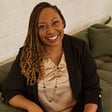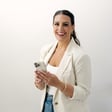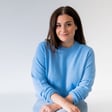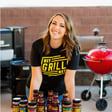Become a Creator today!Start creating today - Share your story with the world!
Start for free
00:00:00
00:00:01

Episode 135: How to Create a Strong Visual Brand
In today's episode Krista and I are covering the components of a strong visual brand identity. We're diving into a few things to consider when it comes to client avatars, logo design, fonts, colors and more. If you're getting ready to tackle brand design project, be sure to check out our Anatomy of a Brand Guide—it's a free download and one of our biggest guides yet. We received some stellar feedback about it so check it out!
For show notes visit...https://daveyandkrista.com/how-to-create-a-strong-visual-identity/
Transcript
Importance of Targeting the Ideal Client
00:00:05
Speaker
When it comes to a brand, your audience is always the first person or first thing that you need to keep in mind because ideally your brand is not just going to be something that you like, but you need to appeal to your ideal client because they're going to be the ones who are spending money with you.
Introduction to the Brands at Book Show
00:00:22
Speaker
Welcome to the Brands at Book Show, where we help creative service-based businesses build their brands and find more clients. I'm your host, Davy Jones.
Components of a Strong Visual Brand
00:00:35
Speaker
In today's episode, Kristin and I are covering the components of a strong visual brand identity. And we're diving into a few things to consider when it comes to client avatars, logo design, fonts, colors, and more. If you're getting ready to tackle a brand design project, be sure to check out our anatomy of a brand guide. It is a free download and it's one of our biggest guides yet. We receive some stellar feedback about it. So people seem to be finding it really helpful.
Engagement and Feedback Channels
00:01:00
Speaker
Be sure to check out the show notes at DaveyandChrista.com for the resources we mentioned during the episode. And we want to hear from you. Let us know what kind of content you'd like to see on the Brands at Book Podcast as we move forward. To leave your feedback, just send us a DM on Instagram at DaveyandChrista. Now on to the episode.
Office Dynamics and Personal Insights
00:01:20
Speaker
Welcome back to another episode of the Brands at Book Podcast. Christa's here again with me up in the office for once. Oh my goodness. Davey.
00:01:30
Speaker
Just for people listening who may not have listened before, that's not a knock. Well, it kind of is, but it's not a knock on you working. You've just been working from downstairs. Yes. Throughout most of the pregnancy. Yeah. Yeah. It's closer to the bathroom, helps to keep my feet up. Yeah, yeah. Well, you know, I have in mind, this is, but this is now my office. I feel like there's some sort of squatter's law. Now I'm going to start changing out all the art in the room. You don't even know how to do that.
Visual Branding for Websites
00:01:57
Speaker
All right, well anyways, we are here, we're talking about creating a strong visual brand identity today. And this is something that I think is, well, maybe it's not fair to say overlooked, but I do think that when people come to us for brand and website design, maybe they're not so sure about brand design, I think the website maybe feels like the more tangible of the two items or functional at least. So I think people are more willing to go
00:02:25
Speaker
kind of just use stuff they kind of find out there for their brand, for their logo, and then say that's good enough. A Canva template or something. Yeah, exactly. And then just say, okay, well, I'm gonna do that for my brand, let's build a website. And I always try to explain to people, and this really isn't, it's not a sales technique or anything, but that when we do brand and website design, or even when somebody has brand design done and comes to us for website design, but they have those brand materials,
00:02:53
Speaker
their website feels like on a different level. Oh, yeah. I mean, if somebody comes to us and they don't have a very strong brand and they're really going to rely on the website, we're really it's going to feel more template-y than if they come to us with all of these other pieces that we're going to talk about today. I mean, it takes it from template to something that feels more polished and cohesive.
00:03:14
Speaker
Absolutely. And the two examples of this that come to mind are the sleep sorority website and the gestured Anna website as counter examples, not, you know, as, as websites that are both semi-custom, right? But that have such strong brands.
00:03:32
Speaker
Becca did the sleep sorority herself, but yes. Okay, yeah, yeah, yeah. But they have strong brands. We did their brand, yeah. Yeah, yeah, exactly. So, but at least, you know, Jessica Jananas comes to mind in terms of a website example where, you know, yeah, it's a semi-custom website, but I don't think people would be able to tell in part because there are just such strong brand elements throughout the site. And she came to us with a brand that another designer had done, but it was just so well done. There were fun colors and graphics to use
00:04:01
Speaker
we knew exactly what fonts to change things to. And so I don't think it feels anything like the template that we started with because she had so many things to work with already. And she knew exactly who her audience is too, which we're going to talk about in a minute. Yeah, absolutely. So that's what we'll dive into today.
Visual Branding vs. Brand Voice
00:04:17
Speaker
We're going to talk about specifically the visual brand and there is a difference or there is a distinction there between, you know, just brand design, brand design in general, but you know, you have the visual brand side of things, which is what we're going to talk about today.
00:04:28
Speaker
And then you have another side, you know, where you would be talking about like things like brand voice. And that would be something that you would want to cover with a copywriter. Yeah. So let's jump in. When we start talking about brand design, maybe I should say this at the outset, you know, or we should sort of talk about this at the outset. So people have, you know, the right expectation, you know, after listening to this episode.
00:04:51
Speaker
With website design, I feel fairly confident saying to people, hey listen, if you have a specific budget that precludes custom or semi-custom website design and you need to get a website design, yes, you can do that. Go on our website or somebody else's or whatever and get a template and start there. And I feel confident that people can end with a product that's gonna look pretty good. What about with brand design? Do you feel like that is something that people can do on their own?
00:05:20
Speaker
If they want something really simple, I think that they can. And we actually have a tutorial out there for making a just text logo in Illustrator in Canva and exporting it. But I think that if you want something that has a defined color palette and font palette,
00:05:35
Speaker
and maybe some sort of icon that is representative of our brand, the way that our palm tree is representative of our brand, that I think that it's probably helpful to work with a designer. Because otherwise, if you don't know how to do those illustrations yourself, and you're starting with something like Canva, it's probably a pre-populated design that other people are gonna use, and so it might not feel as unique.
00:05:57
Speaker
Sure, sure. And I think, you know, that's kind of what my gut says too, which is you're not going to be, I think, as able to get as far as you would on the website design side of things by doing it yourself. And just kind of understanding too, you know, if you don't have that design sense, like for me personally, I don't think I would even try to come up with my own brand. I mean, I don't even think you would know where to find fonts.
00:06:21
Speaker
Sure, well, exactly. But I'm just thinking, and obviously I'm cheating because I have a wife who is a designer, right? But I'm thinking about the different businesses that we either run or have started. And for each of them, I help manage or have helped with the creation of some of the websites. And I feel very confident there, especially on the technical side of things, but for brand design, no.
00:06:51
Speaker
It's just funny to even picture you trying to come up with a brand. Yeah, thanks. Thanks. Anyways, let's go through, let's kind of start through, let's just talk about the process, kind of what elements that we're talking about that people who maybe want to take a shot at it on their own should be thinking about, or if just somebody's getting ready for maybe a brand design project, some stuff that they should be thinking about.
Key Brand Elements and Consistency
00:07:13
Speaker
Right, or if you have an existing brand that you like, just things to consider as well. Maybe you have a logo that you really like, but you've never thought about all these other aspects that we're gonna talk about and how you can bring them to life throughout your brand presence.
00:07:27
Speaker
Awesome. So where do we start? I always recommend starting with your audience. We've talked about this before on the podcast, but when it comes to a brand, your audience is always the first person or first thing that you need to keep in mind because ideally your brand is not just going to be something that you like, but you need to appeal to your ideal client.
00:07:45
Speaker
because they're going to be the ones who are spending money with you. You need to resonate with them. And so if they see or come across your brand and it's not using colors or visuals that resonate with them, it's a lot less likely that they're going to want to work with you or contact you or buy from you.
00:08:02
Speaker
Yeah. And I think that this is an easy thing to skip because people think, you know, Oh yeah. Yeah. Of course I have an idea of who my ideal client is, but I would highly recommend that people go through the process of creating a client avatar.
00:08:16
Speaker
Oh yeah, and the more specific that you can be, the better. Even big brands like Apple and Target don't try to appeal to everyone. Some people are always going to be like high-end boutique shoppers and not Target people. And Target knows that, and so their brand reflects like a very specific person. And same with Apple. Some people are always going to be Microsoft people. I'm not sure why, but there are Microsoft people out there.
00:08:41
Speaker
Yeah, and I just think this is an activity that's not just good for brand design specifically, certainly for the brand voice side of things as well. And when you're coming up with copy for your website or for Instagram post or for whatever, it's just a really useful activity. And you might surprise yourself too as you dig into it to what level you can bring it to.
00:09:03
Speaker
Yeah, we ask people to think about the gender of their ideal client, where they shop, how they spend their free time, what kind of art decorates their walls, where they just make purchases and just where they live. And when you can think of all of those things and pull them together, a lot of times visuals start to speak for themselves. So maybe you know that your ideal client shops at Zara and restoration hardware.
00:09:30
Speaker
And even if you go to look at visuals for their brands, you're probably gonna start to see consistency among colors and typefaces and even the styles of images that those brands are sharing. And so I think that makes the next activity a lot easier too.
00:09:43
Speaker
We have our audience, we've come up with some sort of client avatar and it's okay just as a note to have more than one client avatar. You might have different types of clients that you serve. So go through it, go through that activity for the different clients that you need to serve. And this maybe is just a good, actually I think I've done an episode maybe with Jess on client avatars. Maybe, I can't remember at this point. Jess has been on a couple times.
00:10:06
Speaker
Yeah, so check out that. But maybe another episode is in order just to review coming up with a client avatar and a few things around that.
Tools for Visual Direction
00:10:15
Speaker
But after we're done that, moving on to a mood board. So what's the point of a mood board? Am I going to do anything with a mood board?
00:10:22
Speaker
You're probably not going to share it publicly unless like you really love your mood board and you want to share it with like social media. But a mood board isn't something that most people are ever going to see. A mood board really, it's something that our team uses to help determine visuals. So once we have that avatar and
00:10:39
Speaker
especially if an avatar mentions a lot of very specific brands or specific activities that someone does will start to pull images from those places so somebody tells me that their ideal client spends their vacation time in tuscany
00:10:54
Speaker
and they like to wear Zara. I'll use Zara again because I know they go together. Then I can start pulling images from both of those brands. So maybe I get some like beautiful landscape images from Tuscany. Maybe I find a bottle of like Tuscan wine. Maybe I pull images from Zara. Maybe I go and do a Pinterest search and search for Zara email newsletters because email newsletters can contain a lot of great visuals from brands.
00:11:22
Speaker
And I can start to put all of those pieces together into the mood board. And then from there, a lot of times the look and feel just kind of naturally emerges. So you'll probably see consistencies among colors, among fonts, among overall imagery style. And then that's something that you can take and use for the other elements that we'll talk about in the brand.
00:11:41
Speaker
What I usually tell clients is when they get the mood board or the purpose of the mood board is just for us to make sure we're on the same page aesthetically. It's not to say like, Oh, you use this specific image. I don't love that image. I don't want that image on my website. It's usually just a hint at look and feel. Yeah, absolutely. And it is good test. I think just kind of a good, you know, litmus litmus test for whether we're on, you're heading the right direction. Yeah.
00:12:06
Speaker
And if you want a free template that we have that you can start to do this for yourself, we'll include a link in the show notes because we have a free template for Photoshop that you can download. Next, after the mood board, we would start moving into logo design, right?
00:12:20
Speaker
Yeah. I mean, a logo is probably the most common thing we think of when we think of a brand. So it's the Nike swoosh, it's the Coca-Cola like scripty font. I don't know if you've ever noticed in the FedEx logo, there's a hidden arrow in between the E and the X. I try not to think about FedEx. FedEx is UPS is better.
00:12:39
Speaker
I feel very strongly about this is one of those just weird things that I feel very strongly about and I and I apologize if there's any you know FedEx if people you know are FedEx loyal out there well if you look at their logo there's a hidden arrow in the typography and that was intentionally designed to like imply the idea of moving forward you know like motion
00:13:01
Speaker
Like the Amazon smile that also is an arrow. If you've noticed that, you're nodding your head. I mean, everybody's seen it, right? It's on that bright blue on the side of their trucks. As far as, I mean, so how do we approach logos? I mean, I think that a lot of times when people come in, I think we work with clients that
00:13:20
Speaker
Come in with some sort of idea of what they want for a logo and others who just let the process reveal that. Any notes on logos that you should cover with people? I think that a lot of people think that they're the make or break of a brand, but that is probably as far from true as possible. Yes, if you have an amazing logo, that can totally strengthen your brand.
00:13:45
Speaker
But I think anthropology is a great example. Their logo is very simple. It's just typography and kind of like a typewriter-y looking typeface. As far as I know, they don't have any icons that go with it other than typographical elements. And I think so many of us, especially in the creative industry, love anthropology.
00:14:04
Speaker
and really resonate with their brand and that's because of all of the other elements of their brand. It's the colors that they use. It's the way that their website looks. It's the smells and the layout of their store and just their overall brand presence and so all of these things go together to make a brand.
00:14:21
Speaker
For you, if you're just getting started or you don't know exactly what you want, a simple logo can work really well for a brand. I wouldn't stress too much about a logo. Logos can also evolve and change. I think Coca-Cola has evolved their logo every decade since its existence. Our logo to a certain extent has evolved over time, not the palm tree. The palm tree has been the one consistent.
00:14:45
Speaker
I made that in college and we just always loved it. Yeah. Yeah. Absolutely. Even though we've recently traded the beaches for the mountains. Yeah. I mean, I would agree with all that. I would say that, you know, brand design, you know, good brand. If when you experience a company, right, it's all of those things that come together that you were just mentioning.
00:15:03
Speaker
All right, cool. Well, I think you have said all there needs to be said about logo design for right now. All right, moving on to some of these other things, let's talk colors and fonts.
Brand Identity Through Color and Fonts
00:15:13
Speaker
How much does this make a difference? I think it makes a pretty big difference. So if you've gone through a mood board activity or made a mood board for yourself, it's possible that you came up with a color palette. And so a color palette is just a group of several colors that you use consistently throughout your brand.
00:15:31
Speaker
And while consistent color use may not seem like it's that vital, if you think about target red or Southwest Airlines blue, red and gold, like you would probably see those, any of those colors. If you see those like three colors, you probably recognize that it's Southwest and not like Delta.
00:15:48
Speaker
And likewise, if somebody were to hand you a little teal jewelry box with a white ribbon, I bet you know exactly what's inside. So color goes a long way. And I asked the question because I feel like they also make a big difference. And I think it's two of the things that nobody comes to the brand design process and is like, I really just want to nail my fonts and colors.
00:16:08
Speaker
You know, it's like all about the logo design. It's all about the submarks, which I don't think we didn't talk about submarks, did we? We should talk about submarks because people have lots of questions about submarks. And I do think, you know, personally, I'm a fan of a good summer. Yes, we'll talk about submarks after this. Yeah, colors and fonts. But I do think that they make such a big difference when it comes to a website. And when you go to a website, like you said, that either
00:16:30
Speaker
uses colors inconsistently or uses colors that don't quite work together. Fonts, you know, another thing like, and this I think is most apparent as you're scrolling down a page and it's just jumping from, you know, different fonts to different scripts. I mean, I don't know all the words, wait.
00:16:47
Speaker
But you can tell right? And let me add one more thing about color. There's a lot that goes into choosing colors and color theory because colors communicate different things like red and communicates bold and anger and like taking action now and like strong and lighter softer colors tend to communicate a more sophisticated high-end brand so
00:17:07
Speaker
all of that ties back to your ideal client and what you want to say to them through your brand. So that's another reason why colors are really important, even if someone like you might overlook them. Sure. Sure. Um, well, I, you know, I was just saying, I, I just took that. I just took that right on the chin. You're like someone like you. Yeah. Okay. All right. Okay. We'll move on. We're going to talk about submarks real quick. No, no, I have more to say about fonts.
00:17:32
Speaker
All right. Because fonts, it's the same. All right, out with it. It is the same theory. Different fonts, they might have different weights or they might just have a different look and feel to them. Like there was a period in time in the photography industry where like Trajan Pro or Papyrus were really popular.
00:17:49
Speaker
All of these fonts were created for specific meanings and for specific purposes, and fonts communicate just as much as color. I bet if you looked at the Tiffany's logo and the Claire's logo, you could tell which one is gonna be more high-end just by looking at the logo, and both of them are very simple. The typography is the only thing that sets them apart.
00:18:11
Speaker
When it comes to choosing fonts, I always try to make sure that they coordinate with the logo. And it's always a good idea to limit the number of fonts that you use. So a good rule of thumb is going to be one Sarah font. So Sarah font is the font with a little feet on it. One sans Sarah font, so a font without a little feet on it. And then one display font. So that might be something like a script. Like I would never bring in multiple scripts into a brand because it starts to get confusing and that's when brand is going to start feeling diluted.
00:18:41
Speaker
Anything else to say about fonts? I mean, I agree. And I think that fonts too, just from a user experience perspective on a website, it makes a difference.
Versatility in Branding with Submarks
00:18:50
Speaker
So submarks. One of the reasons that I want to talk about submarks or secondary logos or sublogos is that when I'm on a call with somebody and I'm walking through the brand design process, people often are like, well, what's that?
00:19:00
Speaker
A submark is typically an alternate version of your logo. So a lot of times you have your main version of your logo, but then maybe you need a version of it without the icon or maybe you need a version of it that is stacked or in a circle or it has like a different, like maybe it's just your tagline and your icon. And so when we're working on brands, whenever we can, we try to throw in a bunch of different submarks.
00:19:22
Speaker
because there might be other cases where you use them. Like maybe a sub-mark looks better on the back of a business card or maybe it's a sub-mark that looks good on social media instead of your full big main logo which some of them have like lots of elements and so sometimes you just need something more simple. All right, awesome. I think that does it. I do think that having sub-marks gives you like a little versatility and I just like looking at it. Yeah, they're kind of fun to look at. Yeah.
00:19:49
Speaker
Anyways, moving on, we have a few other things to talk about imagery. What do we have to say about imagery?
00:19:56
Speaker
I feel like you're on the same thread with images as with fonts and colors. I've already mentioned that I value fonts and colors. And imagery, I feel like we talk about a decent amount. Yeah, imagery is pretty vital. The kind of images you use should be the kind that fit with your overall brand and that probably resonate with your ideal client. So if your ideal client is shopping at some place like Pottery Barn or Zara,
00:20:20
Speaker
you probably aren't going to use like super dark moody contrasting images on your site because that's not going to be consistent with what your clients are drawn to. And then one big thing that I think a lot of people don't think about when it comes to imagery is like let's say that your photographer and all of your images are really light and bright and happy and cheerful. You want to make sure that your headshot fits with that aesthetic. Like your headshot should look like it was maybe taken by you. You wouldn't want to have your friend who has really dark contrasty
00:20:50
Speaker
Moody images, take your headshot and then upload that to your website because it's going to feel inconsistent. And so like wherever your images appear, whether it's on social media or your website or in emails, you want to make sure they all look cohesive and like they fit together. So if you're a professional photographer, who's again, whose images are happy, bright, light, airy, you wouldn't want your Instagram feed to be inconsistent with that. Everything should flow together.
00:21:17
Speaker
Yeah, and I think that really covers kind of our next point about being consistent.
Consistency in Branding
00:21:21
Speaker
And I think that's the biggest thing, or one of the biggest things, especially from the client experience side of things, to build brand trust is to be consistent in what you're sharing from your business.
00:21:33
Speaker
Yeah. I mean, and this even goes on to like every part of your brand. Like if you send a client gift, you'd want to make sure that the gift overall matches the look and feel of your brand. So like if you're a newborn photographer who has like soft, airy, light images, and you're trying to appeal to like the anthropology kind of family, you'd want to make sure that you're sending a unique gift that fits that aesthetic. So
00:21:59
Speaker
I wouldn't drop ship something from Amazon. I'd probably source like an organic baby gown, newborn bringing home gown, wrap it in like handmade paper or just like something that feels super thick and expensive, tie it with a really nice kind of bow and then hand write a note.
00:22:18
Speaker
Like everything flows together to establish your brand. And that's how brands like anthropology have built so much with something so simple. You know, for people who are saying, okay, well, I've done this or, you know, they go and do this and they focus on these different elements from, you know, the client avatar to the logo design, fonts and colors and so on, you know, and are ready to make updates to their website. You know, how do we recommend tackling that?
00:22:46
Speaker
I recommend starting with the fonts and colors because I think that that goes a long way towards generating a look and feel on your website. So if even if you just put in your new color palette and then put in your font palette and start to implement those consistently, that's going to make a big difference towards the overall look and feel of your website and your brand.
00:23:05
Speaker
And I know for Showit, for instance, they have brand tools where you can go and make those updates and they globally adjust the settings. Is that the same with Elementor as well? It is, yeah. Okay, awesome. So it is really easy. Like, you know, you can update it in one place. It's going to update in most global set, like areas, you know, of the template or website that you're using. So it really, instead of going through page by page, element by element,
00:23:29
Speaker
You might just feel a little more momentum that way. Cool. Is there, you know, anything else that we need to
Aligning Visuals with Brand Voice
00:23:35
Speaker
cover?
00:23:35
Speaker
I think that we can't stress enough that like, this is just the visual part of a brand. And there's a whole nother like psychological part of a brand, brand voice that we aren't diving into, but that people like Chester Danna do. And working with somebody to create a strong brand voice is going to go a long way because visuals are only going to get you so far. I think that when your words and the copy that you're using can appeal to your ideal client as well, that's going to be like the trigger that makes them book with you.
00:24:04
Speaker
Yeah, absolutely. And it really does all go together. And I would say each part is super important. Once you know somebody really well, you can kind of see them at a distance and be like, oh, that's Krista coming around the corner or whatever. And then same thing if you were just to hear someone talk, right? And you probably think of some of your closest friends and some of the things that they would say where they're telling you that it's you, but not telling you that it's you.
00:24:33
Speaker
just maybe they have certain phrases that they say all the time and so you kind of hear them again coming around the corner and it's like, oh yeah, it's definitely them, right? Yeah, I think you want to evoke something, sort of a similar feeling with your brand as well so that people immediately recognize it both visually, but then also just by hearing it and being able to understand, okay, yeah, for sure, that's definitely whatever brand. And both of those things I think really come together to form a strong brand
00:24:59
Speaker
and when they don't, or when there's a disconnect to between the brand voice that you're using and maybe it sounds value, whereas your visual brand identity is high end and luxury, right? There's a disconnect there. And I think anytime there's a disconnect like that, it doesn't build trust. I think that when people do brand voice well, that's really what makes their clients fall in love with them.
00:25:20
Speaker
Yeah, yeah.
Final Thoughts on Brand Design
00:25:22
Speaker
And we said that in other podcasts and YouTube videos as well is, and I think something that we see because we're in a creative industry, we work with a lot of creative clients who value imagery, is sometimes the voice part is overlooked. So we don't have to go into that again. All right, well, that's that for visual brand identity, all you need to know. Okay, maybe not all you need to know.
00:25:44
Speaker
All right. But, uh, enough to get you started, especially if you're thinking about working on brand design. Like I said, at the beginning of this episode, you know, I think that knowing your strengths, right? And, uh, and anytime you can do your something yourself, I feel like I'm quick to say, yeah, give it a shot. You know, talk to people about Facebook ads all the time and who, you know, maybe they have never run an ad campaign before.
00:26:05
Speaker
And I always suggest going out and running your own ad campaign before finding agency to do it for you You know in most cases and so I think there's a lot of value in doing stuff yourself I would say that this is one of the few areas where I'd say
00:26:19
Speaker
If you don't feel like this is one of your gifts, maybe just find a brand designer to help on some level, whether it's with a semi-custom brand or whatever. So anyways. If you want to learn a little bit more about this or see us bring a brand to life, like a good example brand, we have a free guide that you can download, the anatomy of a brand guide, and we'll link to that in our notes. Absolutely. Well, thanks for coming and joining me in the office. Thanks. All right, bye guys.
00:26:51
Speaker
Thanks for tuning into the Brands That Book Show. If you enjoyed this episode, please consider subscribing and leaving a review in iTunes. For show notes and other resources, head on over to dvandchrista.com.
















